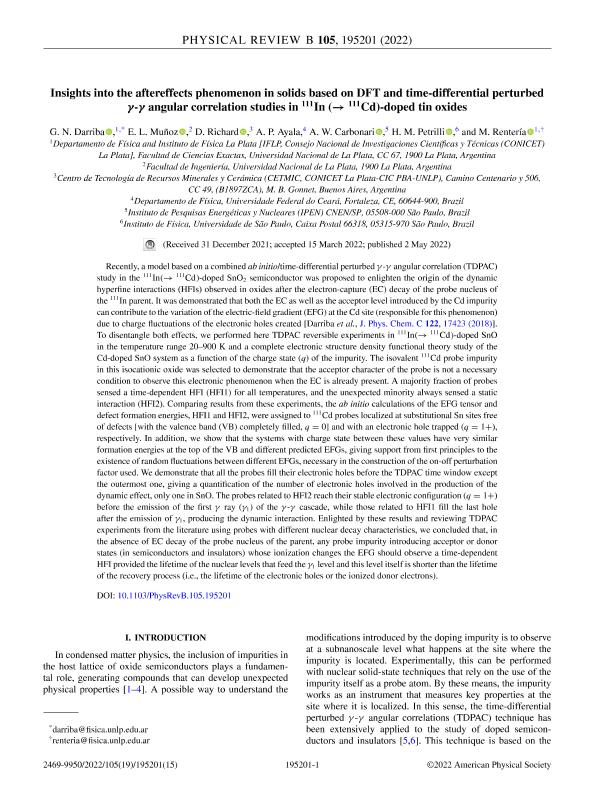Artículo
Insights into the aftereffects phenomenon in solids based on DFT and time-differential perturbed γ-γ Angular correlation studies in 111In (→ 111Cd) -doped tin oxides
Darriba, German Nicolas ; Muñoz, Emiliano Luis
; Muñoz, Emiliano Luis ; Richard, Diego
; Richard, Diego ; Ayala, A. P.; Carbonari, A. W.; Petrilli, H. M.; Rentería, Mario
; Ayala, A. P.; Carbonari, A. W.; Petrilli, H. M.; Rentería, Mario
 ; Muñoz, Emiliano Luis
; Muñoz, Emiliano Luis ; Richard, Diego
; Richard, Diego ; Ayala, A. P.; Carbonari, A. W.; Petrilli, H. M.; Rentería, Mario
; Ayala, A. P.; Carbonari, A. W.; Petrilli, H. M.; Rentería, Mario
Fecha de publicación:
05/2022
Editorial:
American Physical Society
Revista:
Physical Review B
ISSN:
2469-9969
Idioma:
Inglés
Tipo de recurso:
Artículo publicado
Clasificación temática:
Resumen
Recently, a model based on a combined ab initio/time-differential perturbed γ-γ angular correlation (TDPAC) study in the In111(→Cd111)-doped SnO2 semiconductor was proposed to enlighten the origin of the dynamic hyperfine interactions (HFIs) observed in oxides after the electron-capture (EC) decay of the probe nucleus of the In111 parent. It was demonstrated that both the EC as well as the acceptor level introduced by the Cd impurity can contribute to the variation of the electric-field gradient (EFG) at the Cd site (responsible for this phenomenon) due to charge fluctuations of the electronic holes created [Darriba, J. Phys. Chem. C 122, 17423 (2018)10.1021/acs.jpcc.8b03724]. To disentangle both effects, we performed here TDPAC reversible experiments in In111(→Cd111)-doped SnO in the temperature range 20-900 K and a complete electronic structure density functional theory study of the Cd-doped SnO system as a function of the charge state (q) of the impurity. The isovalent Cd111 probe impurity in this isocationic oxide was selected to demonstrate that the acceptor character of the probe is not a necessary condition to observe this electronic phenomenon when the EC is already present. A majority fraction of probes sensed a time-dependent HFI (HFI1) for all temperatures, and the unexpected minority always sensed a static interaction (HFI2). Comparing results from these experiments, the ab initio calculations of the EFG tensor and defect formation energies, HFI1 and HFI2, were assigned to Cd111 probes localized at substitutional Sn sites free of defects [with the valence band (VB) completely filled, q=0] and with an electronic hole trapped (q=1+), respectively. In addition, we show that the systems with charge state between these values have very similar formation energies at the top of the VB and different predicted EFGs, giving support from first principles to the existence of random fluctuations between different EFGs, necessary in the construction of the on-off perturbation factor used. We demonstrate that all the probes fill their electronic holes before the TDPAC time window except the outermost one, giving a quantification of the number of electronic holes involved in the production of the dynamic effect, only one in SnO. The probes related to HFI2 reach their stable electronic configuration (q=1+) before the emission of the first γ ray (γ1) of the γ-γ cascade, while those related to HFI1 fill the last hole after the emission of γ1, producing the dynamic interaction. Enlighted by these results and reviewing TDPAC experiments from the literature using probes with different nuclear decay characteristics, we concluded that, in the absence of EC decay of the probe nucleus of the parent, any probe impurity introducing acceptor or donor states (in semiconductors and insulators) whose ionization changes the EFG should observe a time-dependent HFI provided the lifetime of the nuclear levels that feed the γ1 level and this level itself is shorter than the lifetime of the recovery process (i.e., the lifetime of the electronic holes or the ionized donor electrons).
Archivos asociados
Licencia
Identificadores
Colecciones
Articulos(CETMIC)
Articulos de CENTRO TECNOL.DE REC.MINERALES Y CERAMICA (I)
Articulos de CENTRO TECNOL.DE REC.MINERALES Y CERAMICA (I)
Articulos(IFLP)
Articulos de INST.DE FISICA LA PLATA
Articulos de INST.DE FISICA LA PLATA
Citación
Darriba, German Nicolas; Muñoz, Emiliano Luis; Richard, Diego; Ayala, A. P.; Carbonari, A. W.; et al.; Insights into the aftereffects phenomenon in solids based on DFT and time-differential perturbed γ-γ Angular correlation studies in 111In (→ 111Cd) -doped tin oxides; American Physical Society; Physical Review B; 105; 19; 5-2022; 195201-195201
Compartir
Altmétricas



